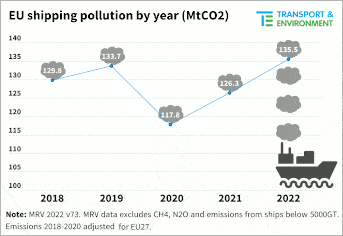
In Europe, CO2 emissions from maritime transport,
after the decline coinciding with the global spread of the pandemic of
Covid-19, have returned to pre-health crisis levels
reaching a new all-time high. This is highlighted by an analysis of
Transport & Environment (T&E), the organization
environmentalist whose purpose is to promote the reduction
the polluting impact of the transport sector, which is disclosed
as in 2022 the volume of carbon dioxide emissions generated
the services of the shipping industry operating in Europe and
135.5 million tonnes compared to 126.3 million tonnes
million tonnes of CO2 in the previous year and compared to
133.7 million tons produced in 2019 before falling to
117.7 million tonnes in 2020 coinciding with the
worldwide spread of the pandemic.
 Recalling that European maritime operators annually
must by law transmit their emission data to the EU, and
that in recent years T&E uses this data to evaluate how
emissions from shipping in Europe have evolved,
The environmental organization has specified that the data obtained
from the EU that it published last July do not include those of
many operators who have failed to provide data on
emissions on time, which means that the total emissions of the
European maritime transport are now much higher than
those previously reported.
Recalling that European maritime operators annually
must by law transmit their emission data to the EU, and
that in recent years T&E uses this data to evaluate how
emissions from shipping in Europe have evolved,
The environmental organization has specified that the data obtained
from the EU that it published last July do not include those of
many operators who have failed to provide data on
emissions on time, which means that the total emissions of the
European maritime transport are now much higher than
those previously reported.
The report also states that the increase in emissions is
also due to the fact that in 2022 the number of ships calling at the
European ports grew considerably to 12,953
compared to 12,211 ships in 2021, 12,045 ships in 2020 and 12,395
in the pre-pandemic year of 2019.
T&E's analysis highlights that at the top of the list
The continent's largest carbon emitter figure
The main containerized shipping companies starting from
from MSC, which is a world leader in the sector and which in 2022
emitted over 10.5 million tons of CO2, followed by
those of other leading carriers in the sector: CMA CGM (5.4 million
tonnes of CO2), Maersk (5.3 million), COSCO (3.8 million) and
Hapag-Lloyd (3.3 million).
The document also notes that in 2022 ship emissions
from cruising were more than double compared to the year
precedent when cruise activity was strongly
reduced due to the health crisis. Significant growth is
emissions from ships transporting
liquefied natural gas, a type of cargo that last year was
increased by +60% as Europe was intensifying
sanctions on Russian oil, with a consequent boost to
LNG imports into Europe by sea.
In first place among the types of ships that in 2022 have
produced the largest amount of CO2 emissions are however
Container ships left with 37.9 million tons of carbon dioxide
carbon followed by bulk carriers with 18.3 million tonnes,
oil tankers with 16.7 million, ferries with 13.5 million,
from LNG ships with 10.7 million tons, from chemical tankers with
8.7 million, cruise ships with 6.9 million and ships
ro-ro with 5.5 million tons.
The analysis also specifies the amount of CO2 emissions
produced by ships in European ports, a volume that in 2022 is
result of 8.6 million tons, in 2021 of 8.0 million, in the
2020 of 7.5 million and in 2019 of 9.5 million tons.